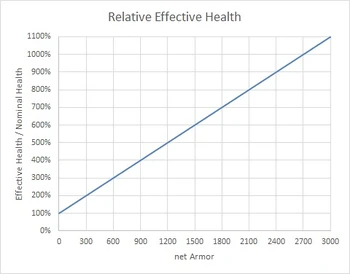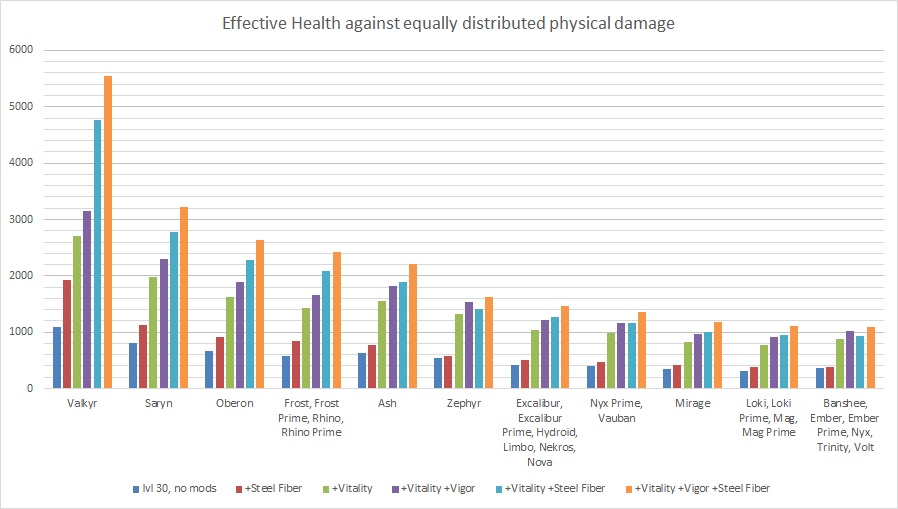(新頁面: :''Not to be confused with Cosmetic Armor.'' '''Armor''' is an attribute that reduces damage taken by certain entities. Damage taken on their health is red...) 標籤:rte-source |
Honestleaf(留言牆 | 貢獻) |
(無差異)
| |
於 2015年8月30日 (日) 10:54 的修訂
- Not to be confused with Cosmetic Armor.
Armor is an attribute that reduces damage taken by certain entities. Damage taken on their health is reduced, until the armor is depleted. All armored entities have an armor value and as well as an armor type. Finally, there is a quantity of armor health (apart from Warframes, which are always fully armored). Notable armored entities include Warframes, most bosses, and all Grineer. This article investigates the mechanics of this reduction and its effect on damage.
The following is an explanation of the three terms (armor value, armor type, and armor health):
- Armor values indicate the effectiveness of the armor, and are generally set for each entity. However, they can vary, depending on the type of entity: Warframe values can be modded, while enemy armor scales, increasing with level. Certain abilities and debuffs can change temporarily change this number as well.
- There are two types of armor, Ferrite and Alloy. All armor has percentage modifiers to the damage types, indicating specific resistances and vulnerabilities. These mean that the net effect of armor is less against certain types of damage. Both the flesh type damage modifier and the armor modifier are combined when calculating effective damage.
- Finally, enemies have their own amount of armored health relative to their flesh health. When the armor health is gone, armor does nothing: there is no damage reduction and enemies revert to taking normal flesh damage. All armor health values are noted on each enemy's page.
Effect of armor
When damage is inflicted to a target with armor health, that damage is mitigated by the target’s armor value. Thus, the target’s health can absorb more points of gross damage than its nominal value. Therefore, there are two ways how the armor functionality can be imagined: either as a reduction to damage, or as an increase of (effective) health.
Armor as Damage Reduction

Damage inflicted to health points is mitigated according to the following formula:
Net damage = gross damage / ( 1 + net armor / 300 )
This asks how much net damage is inflicted, if a certain amount of gross damage is applied. As armor increases, the denominator increases and an inversely proportional relationship
An armor value of 300 will divide the gross damage by ( 1 + 300 / 300 ) = ( 1 + 1 ) = 2, so only half of the gross damage is inflicted as net damage. At 900 armor, damage is divided by 4, so only a fourth of the gross damage is inflicted as net damage, and so on.
Armor as Effective Health Increase

A powerful alternative way to think of armor transforms the above equation to the following:
Net damage * ( 1 + net armor / 300 ) = gross damage
And asks how much gross damage needs to be applied, until a certain amount of net damage is inflicted. While this may be less intuitive when considering damage, it is useful for calculating survivability. In order to change perspective away from the target one speaks of health rather than damage. Net damage switches to nominal health, and gross damage becomes effective health.
Effective health = nominal health * ( 1 + net armor / 300 )
An armor value of 300 will multiply the nominal health with 2, so the effective health will be double the nominal health. At 600 armor, it’s three times the nominal health, and so on.
Armor type
- See also: Damage 2.0 § Damage Calculation
There are two types of armor, Ferrite and Alloy. Both are strongest against 腳本錯誤:函數 "Proc" 不存在。 damage and weaker against 腳本錯誤:函數 "Proc" 不存在。. The main difference is in the elemental weaknesses, which are completely different. Ferrite armor is relatively common with mid-level enemies such as Lancers and Troopers, and has generally weaker resistances than the more advanced Alloy Armor, which is used by Bombards, Napalm, and other bosses.
Damage type modifiers inherently affect armor's effectiveness. They are linked by the following equation:
Net armor = gross armor * ( 1 – type armor modifier )
Apart from this armor value modification, type damage modifiers against the armor and health type of the target also affect the damage as independent factor. Therefore, all put together, the formula for damage modification considering armor and damage types is:
ND = GD * ( 1 + TAM ) * ( 1 + THM ) / ( 1 + AR/300 * ( 1 – TAM ) )
Where ND is the net damage, GD the gross damage, TAM the type armor modifier, THM the type health modifier and AR the armor (before type modification).
Conversely, the effective health of a target against a certain damage type is:
EH = NH * ( 1 + AR/300 * ( 1 – TAM ) ) / ( 1 + TAM ) / ( 1 + THM )
Where EH is effective health and NH is nominal health, other abbreviations consistent with above.
When calculating exact net damage or effective health values for more than one type of damage being applied at a time, most notably for weapons which usually apply more than one damage type, TAM and THM are the weighted averages of the individual participating damage types; weighted by their relative amounts:
TMtotal = TM1 * GD1/GDT + TM2 * GD2/GDT + TM3 * GD3/GDT + ...
With these formulas, accurate damage calculations are possible.
Warframe armor values
The armor value of Warframes is always the same for that Warframe, and the armor type is Alloy and their health type is Flesh. Their armor health never depletes. While there is no such thing as a general effective health value, since effective health depends on the damage type the health is subjected to, a reasonable benchmark to compare the durability of Warframes is their effective health against equally distributed physical damage, i.e. equal portions of Impact, Puncture and Slash, since the vast majority of enemy damage against players is comprised of these types. Inserting these assumptions into the previous formula, we get:
EHIPS = NH * 60/53 * ( 1 + 67/60 * AR/300 )
As a meaningful PvE benchmark. For actual values, see the figure below.
High Nominal Health vs High Mitigation
Although both affect effective health and combine multiplicatively, one may have to decide between increasing nominal health or damage mitigation (i.e. armor or the strength of some damage mitigating abilities) in some builds. There are a few things to consider apart from the total gain in effective health:
- Higher Mitigation will increase the amount of effective health you regain from heals that restore a fixed amount of nominal health points, e.g. red orbs, blue orbs with Equilibrium and lifesteal from Life Strike or Well Of Life.
- Higher Nominal Health will increase the amount of energy you get out of the depletion of your health pool with the Warframe mod Rage.
Steel Fiber
Steel Fiber is currently the only mod in the game that increases a Warframe’s armor value, and it does so by a percentage. Therefore, Warframes with higher base armor values have a higher benefit from it. Neglecting damage type modifiers, the relative increase is in effective health from this mod is SF * (1-1/(1+AR/300)), where SF is the effect from Steel Fiber. For example, for Warframes with the common base armor value of 65, the benefit of a maxed Steel Fiber is only about +19.6%, whereas the benefit of a maxed Vitality at level 30 is +246.7% (though keep in mind, the +19.6% apply to red orbs etc. as well). More on Steel Fiber can be found on the respective article.
Abilities that boost Warframe armor temporarily are Valkyr’s Warcry, Oberon's Hallowed Ground, and Rhino’s Ironclad Charge.
Enemy Armor Values
Enemy armor values scale to the enemy's level. Damage reduction will only be applied if the enemy has armored health remaining, as indicated by yellow portions of their health bar. Generally only Grineer and boss enemies have armor, while the Corpus and Infested factions do not have any.
Scaling of enemy armor values uses the following formula:
Armor = base Armor * (1 + ((current Level - base Level)1.75 / 200))
- base Armor: Base armor value for the enemy.
- current Level: The level of your target enemy.
- base Level: This is the initial level an enemy can spawn. This is important because certain enemy types, such as Heavy Grineer, will not spawn until certain levels (like level 8 for Heavy Gunners), so while they may be level 30, their armor has only scaled up 22 times.

This graph shows the amount of armor for Grineer Heavy Gunner up to Level 120.
As mentioned before, this formula causes high level Grineer (lets say up from level 50) to be very hard to kill, as you can see in the example of a level 108 Heavy Gunner:
500 * (1 + (((108 - 8) ^ 1.75) / 200)) = 500 * (1 + (3162 / 200)) = 500 * 16.81 = 8405 mitigation multiplier = 1 / (1 + (8405 / 300)) = 0.0345
The resulting damage is dramatically reduced to ~3.45% of original damage.
Alternative formula
- base Armor * (1 + ... is equal to base Armor + (base Armor ...
- / 200 is equal to * 0.005
Thus Armor = base Armor + 0.005 * base Armor * (current Level - base Level)1.75 gives the same result as the formula above. This is provided as a more readable format for readers without a mathematics background.
Debuffs
Several debuffs affect enemy armor: Corrosive damage procs, the Corrosive Projection aura, Nekros’ Terrify, and Seeking Shuriken.
See also
- Warframe Attributes
- Steel Fiber
- Damage Calculator
| 伤害计算机制 | ||
|---|---|---|
| 伤害 • 身体部位 • 护甲 • 暴击 • 多重射击 • 贯通 | ||
| 伤害类型 | ||
| 物理 | 冲击 • 穿刺 • 切割 • 终结 | |
| 元素 | 冰冻 • 电击 • 火焰 • 毒素 | |
| 组合 | 爆炸 • 腐蚀 • 毒气 • 电磁 • 辐射 • 病毒 | |
| 遊戲機制 | |||
|---|---|---|---|
| 貨幣 | |||
| 常用 | 軍械庫 • 資料庫 • 每日獻禮 • 鑄造廠 • 商店 • 精通段位 • 午夜電波 • 軌道飛行器 • 星圖 | ||
| 故事 | 善惡偏向 • 碎片 • Leverian • 系列任務 | ||
| 派系 | Corpus • Grineer • Infested • Orokin • Sentient • 集團 • Tenno | ||
| 社交 | 聊天 • 氏族 • 氏族道場 • 交易 | ||
| 小隊 | 主機遷移 • 不活躍懲罰 • 隊伍配對 | ||
| 遊戲 | 經驗 • Buff & Debuff • 死亡 • 傷害 (異常狀態, 傷害類型修正, 免疫) • 地形 • 操控 • 單手操作 • 可拾取物 • 地圖板塊 • 虛空遺物 • 路徑點 | ||
| 任務 | 仲裁 • 九重天 • 突擊 • 戰術警報 • 鋼韌之道 • 虛空裂縫 | ||
| 敵人 | Bosses • 死亡標記 • 敵人行為 • 赤毒巫妖 • 威脅等級 | ||
| 活動 | Captura • 保育 • 釣魚 • K式懸浮板競速 • 街機遊戲 • 挖礦 | ||
| 潛行 | 駭入 • 噪音等級 | ||
| PvP | 決鬥 • 武形秘儀 (月動球) • 戰甲快打 | ||
| 裝備 | Mod與賦能 | 賦能 • 融合 • MOD (裂罅) • 極化 • 轉換 | |
| 戰甲 | 屬性 (護甲 • 能量 • 生命 • 護盾 • 衝刺速度) • 技能 (強化 • Helminth 系統 • 被動能力 • 持續時間 • 效率 • 範圍 • 強度) | ||
| 武器 | 精準度 • 次要射擊 • 彈藥 • 攻擊速度 • 暴擊 • 傷害衰減 • 顯赫武器 • 射速 • 近戰 • 多重射擊 • 拋射物飛行速度 • 穿透 • 後坐力 • 裝填速度 • 射擊模式 • 瞄準 | ||
| 指揮官 | 增幅器 • 專精 (Madurai • Vazarin • Naramon • Unairu • Zenurik) • 晶體 | ||
| 其他 | Archwing • 同伴 • K式懸浮板 • 亡骸機甲 • 萬靈袖刃 • 銳捷號 | ||
| 技術性 | 抬頭顯示界面 • 按鍵設定 • 遊戲設置 • 壓力測試 • 文字圖示 • 掉落表 • 世界狀態 | ||
| 數據計算 | 敵方等級變化規律 • 最大化 • 玩家研究 | ||

